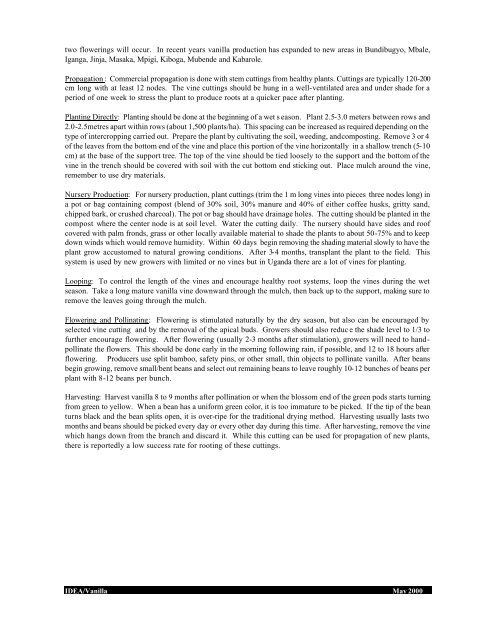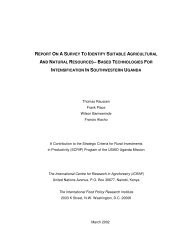ADC Commercialisation Bulletin #1 – Vanilla - Foodnet
ADC Commercialisation Bulletin #1 – Vanilla - Foodnet
ADC Commercialisation Bulletin #1 – Vanilla - Foodnet
Create successful ePaper yourself
Turn your PDF publications into a flip-book with our unique Google optimized e-Paper software.
two flowerings will occur. In recent years vanilla production has expanded to new areas in Bundibugyo, Mbale,<br />
Iganga, Jinja, Masaka, Mpigi, Kiboga, Mubende and Kabarole.<br />
Propagation : Commercial propagation is done with stem cuttings from healthy plants. Cuttings are typically 120-200<br />
cm long with at least 12 nodes. The vine cuttings should be hung in a well-ventilated area and under shade for a<br />
period of one week to stress the plant to produce roots at a quicker pace after planting.<br />
Planting Directly: Planting should be done at the beginning of a wet s eason. Plant 2.5-3.0 meters between rows and<br />
2.0-2.5metres apart within rows (about 1,500 plants/ha). This spacing can be increased as required depending on the<br />
type of intercropping carried out. Prepare the plant by cultivating the soil, weeding, and composting. Remove 3 or 4<br />
of the leaves from the bottom end of the vine and place this portion of the vine horizontally in a shallow trench (5-10<br />
cm) at the base of the support tree. The top of the vine should be tied loosely to the support and the bottom of the<br />
vine in the trench should be covered with soil with the cut bottom end sticking out. Place mulch around the vine,<br />
remember to use dry materials.<br />
Nursery Production: For nursery production, plant cuttings (trim the 1 m long vines into pieces three nodes long) in<br />
a pot or bag containing compost (blend of 30% soil, 30% manure and 40% of either coffee husks, gritty sand,<br />
chipped bark, or crushed charcoal). The pot or bag should have drainage holes. The cutting should be planted in the<br />
compost where the center node is at soil level. Water the cutting daily. The nursery should have sides and roof<br />
covered with palm fronds, grass or other locally available material to shade the plants to about 50-75% and to keep<br />
down winds which would remove humidity. Within 60 days begin removing the shading material slowly to have the<br />
plant grow accustomed to natural growing conditions. After 3-4 months, transplant the plant to the field. This<br />
system is used by new growers with limited or no vines but in Uganda there are a lot of vines for planting.<br />
Looping: To control the length of the vines and encourage healthy root systems, loop the vines during the wet<br />
season. Take a long mature vanilla vine downward through the mulch, then back up to the support, making sure to<br />
remove the leaves going through the mulch.<br />
Flowering and Pollinating: Flowering is stimulated naturally by the dry season, but also can be encouraged by<br />
selected vine cutting and by the removal of the apical buds. Growers should also reduc e the shade level to 1/3 to<br />
further encourage flowering. After flowering (usually 2-3 months after stimulation), growers will need to handpollinate<br />
the flowers. This should be done early in the morning following rain, if possible, and 12 to 18 hours after<br />
flowering. Producers use split bamboo, safety pins, or other small, thin objects to pollinate vanilla. After beans<br />
begin growing, remove small/bent beans and select out remaining beans to leave roughly 10-12 bunches of beans per<br />
plant with 8-12 beans per bunch.<br />
Harvesting: Harvest vanilla 8 to 9 months after pollination or when the blossom end of the green pods starts turning<br />
from green to yellow. When a bean has a uniform green color, it is too immature to be picked. If the tip of the bean<br />
turns black and the bean splits open, it is over-ripe for the traditional drying method. Harvesting usually lasts two<br />
months and beans should be picked every day or every other day during this time. After harvesting, remove the vine<br />
which hangs down from the branch and discard it. While this cutting can be used for propagation of new plants,<br />
there is reportedly a low success rate for rooting of these cuttings.<br />
IDEA/<strong>Vanilla</strong> May 2000
















